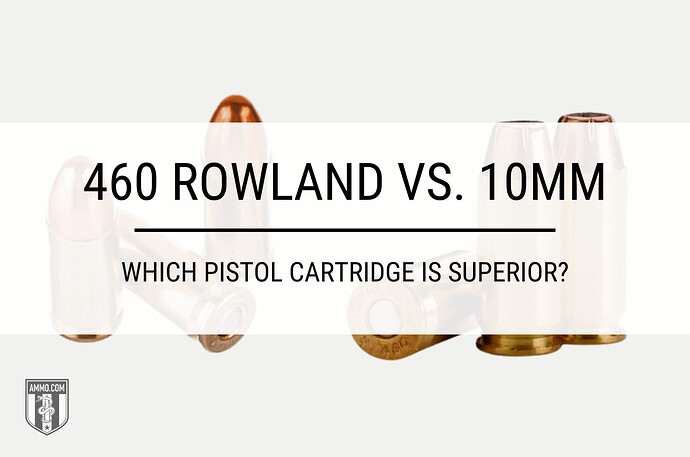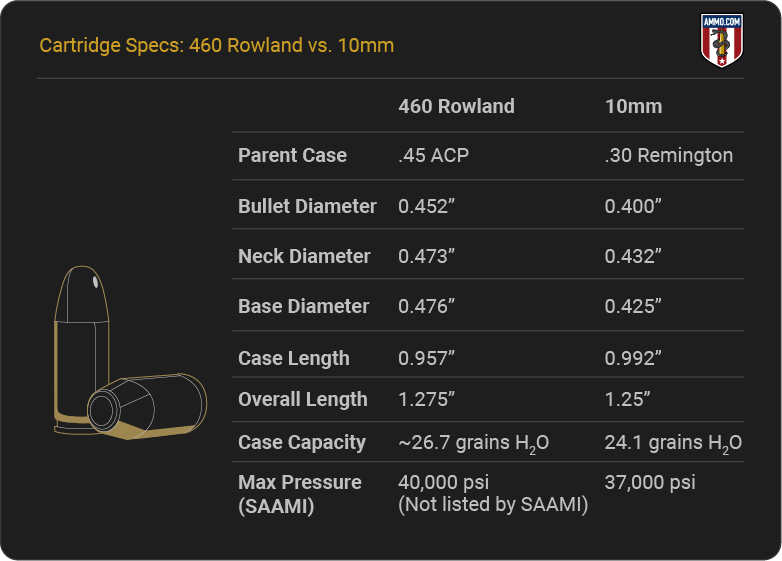The 460 Rowland (sometimes incorrectly spelled Roland) and 10mm Auto are specialty handgun cartridges that make solid wilderness protection rounds. When we compare the 460 Rowland vs. 10mm, which one comes out on top?
Let’s compare the recoil, accuracy, pricing, ballistics, and more to find out!
What’s the Difference Between 460 Rowland vs. 10mm?
Despite being powerful handgun cartridges, many differences make one better than the other in various instances.
Their visual and size differences aren’t that drastic, as we’ll see shortly. However, these minute variations can have significant impacts on real-world performance.
Cartridge Specs
Let’s get into the nitty-gritty details of technical specifications for each cartridge.
The 460 Rowland is the larger cartridge overall, measuring 1.275 in compared to 1.25 in for the 10mm. It’s not a major difference, but it’s noticeable.
The 460 Rowland fires a bullet with a larger diameter (0.452 in) contrasted with the 10mm (0.4005 in).
The 460 Rowland’s longer case (0.957 in) gives it a little more case capacity; roughly the same as the 45 ACP at about 26.7 grains H2O. The 10mm has a case capacity of 24.1 grains H2O.
SAAMI-approved maximum chamber pressure for the 10mm Auto is 37,000 psi. SAAMI has not adopted official specs for the 460 Rowland, although consensus holds that it has a maximum pressure of 40,000 psi.
Let’s see how their dimensions determine real-world performance, beginning with the amount of recoil each cartridge produces.
Recoil: 460 Rowland vs. 10mm
Recoil is a critical consideration for all pistol shooters. A round with heavy recoil (aka “kick”) will be more challenging to control and effectively slow the rate of follow-up shots.
Recoil is the product of propellant weight, muzzle velocity (fps), bullet weight, and firearm weight. Assuming all other variables remain constant, the faster a bullet exits the barrel, the harder it kicks back on the shooter. (That’s just physics, folks.)
A heavier bullet requires more energy to push it out of the barrel at the same velocity as a lighter bullet. The extra resulting recoil energy is returned to the shooter’s wrists (in the case of firing a handgun).
A 10mm firing a 180 grain bullet generally has about 11.4 ft-lbs of energy. While this doesn’t seem like much, it does translate to what most shooters consider to be a snappy pistol-firing experience. That’s why the FBI no longer issues it.
The .460 Rowland has slightly more recoil than the 10mm, although most shooters won’t notice much difference.
This section is a tie, as felt-recoil is extremely challenging to distinguish between the two rounds.
Accuracy: 10mm vs. 460 Rowland
A round’s accuracy is determined by many factors, including the shooter, bullet, firearm, and environmental conditions. Trajectory and recoil also play a role (it’s much easier to be accurate with a round that has low recoil and a flat trajectory).
The accuracy of a cartridge also depends on personal preference, ammo selection, and the firearm you’re firing it in. Ammo retailers love talking about “accuracy,” but at the end of the day, no round is accurate until its owner makes it so.
The slight difference in recoil shouldn’t cause a shooter to flinch more with one than the other, except that the 10mm is more snappy than the 460 Rowland, which can translate into less accurate follow-up shots.
This section is a tie. Both cartridges have a similar amount of recoil, and either can be very accurate by practicing sound fundamentals.
Stopping Power: 460 Rowland vs. 10mm
“Stopping power” is a phrase commonly tossed around campfires, gun forums, and gun store counters. It is entirely unquantifiable, as it is ultimately and solely determined by shot placement. A well-placed shot with a small cartridge will always be more effective at stopping a threat than a poorly placed shot with a larger cartridge.
We can argue about bullet hole size, penetration, and energy transfer capabilities until we’re blue in the face and still get nowhere.
The .460 Rowland has a slight edge because it launches a larger bullet of similar weight at higher velocities. This generates more muzzle energy, translating to more energy available to transfer to the target downrange. It also penetrates better than the 10mm (depending on your chosen bullet).
The 460 Rowland is the first to win a section and takes the early lead. But can it hold on?
Continue reading 460 Rowland vs. 10mm: Which Pistol Cartridge Is Superior? on Ammo.com

